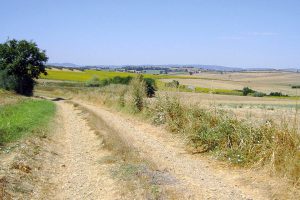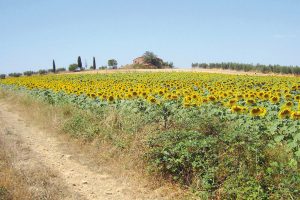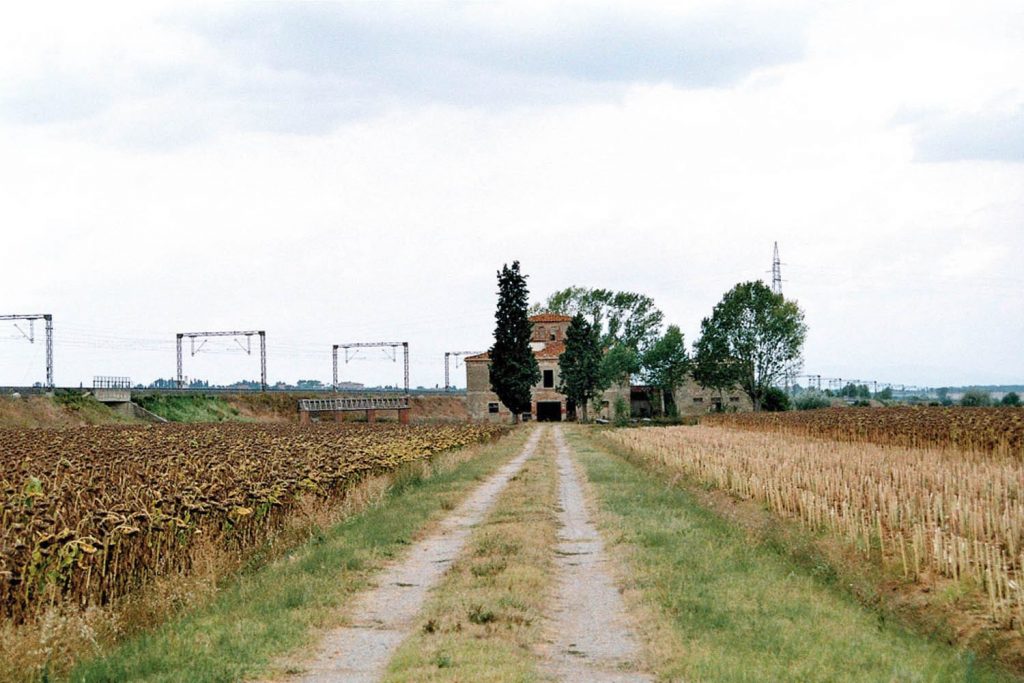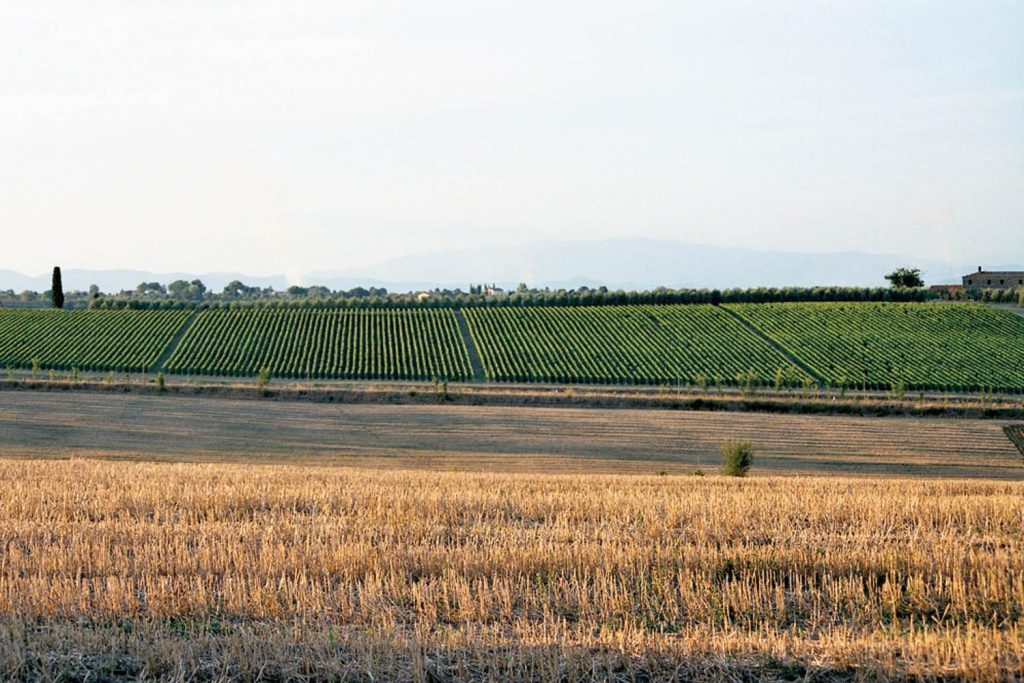Trekking routes in the countryside
The trekking routes in the countryside of Cortona stretch across a particularly interesting area from the naturalistic and anthropic points of view, which is characterized by points of interest like the Canale Maestro della Chiana, Grand Ducal farmhouses, Leopoldine houses and various villages scattered along the valley.
The average height of the valley is around 250 m AMSL, so it is possible to easily cover the routes and paths both by walk and by bike. Corn and sunflower fields harmonically alternate with woods and vineyards.
In addition to natural amenities, tourists can plunge into a world full of art and history, discovering remains of ancient Etruscan roads, country villas and remains of Roman aqueducts, lovely parish churches of the Christian era, which have been found after drainage works carried out for centuries in the Valdichiana.
- Route Fratta – Ronzano – Creti-Fratticciola Distance: Km 13 | Traveling time: 2 hours and 30 minutes | Difficulty: Medium-high
Distance: Km 13
Traveling time: 2 hours and 30 minutes
Difficulty: Medium-highRoute description
 Through the walking and cycling track around the Church of Sant’Agata in Fratta and along the banks of stream Loreto, which flows into the canal Mucchia, you will arrive at the Podere Ronzano. From here, go up on the left towards the little village and pass it by, then take the first dirt road on the right (in Le Casine). At the first crossroads go down on the left and then immediately on the right, on the right and on the left again, and finally go straight on up to the village of Creti. Cover an asphalted road in the direction of Fratticciola, until you find the first dirt road on the left. After Casa Belvedere turn left, continue up to a crossroads and turn then left again. Once arrived in Cerreto turn right and continuing along the main road you will arrive in Fratticciola. Turn left and then right towards the cemetery: a little path leads you to a crossroads, then turn left and right at Podere Marcigliano di Sopra.
Through the walking and cycling track around the Church of Sant’Agata in Fratta and along the banks of stream Loreto, which flows into the canal Mucchia, you will arrive at the Podere Ronzano. From here, go up on the left towards the little village and pass it by, then take the first dirt road on the right (in Le Casine). At the first crossroads go down on the left and then immediately on the right, on the right and on the left again, and finally go straight on up to the village of Creti. Cover an asphalted road in the direction of Fratticciola, until you find the first dirt road on the left. After Casa Belvedere turn left, continue up to a crossroads and turn then left again. Once arrived in Cerreto turn right and continuing along the main road you will arrive in Fratticciola. Turn left and then right towards the cemetery: a little path leads you to a crossroads, then turn left and right at Podere Marcigliano di Sopra.Archaeological information
The area of Fratta (this place name can be referred to the presence of a wood) plays an important role in the archaeological history of Cortona: according to tradition, the famous Etruscan bronze chandelier (4th century B.C.) was found here in 1840. Other texts prove the discovery of Villanovian cinerary urns in podere S. Ranieri, in addition to a healthy source in Acquatini, which was related to problems of fertility and lactation. After the cemetery, dominating a roundabout, we find one of the last two houses built with earth, the so-called “Casine” (the other one is in S. Lorenzo), which have been built by poor farmers who could not afford bricks and cement.To move on, in 1894 an important burial site dating back to the Neolithic Age was found in Battifollo. This excavated tomb contained a buried person, whose grave goods were made up of weapons: two copper axes placed next to the shoulders, a copper dagger and a pot with an arrowhead inside placed next to the head of the departed (MAEC). In the area has also been reported the presence of tombs of the Hellenistic Age (3rd –1st century B.C.).
Artistic and historical information
During the Middle Ages the monastery of S. Biagio and a castle were built in Ronzano, in the area still called La Castellina during the 16th century. Along the route we can see today beautiful Leopoldine houses, some of which are related to the Religious Military Order of Saint Stephen.The first document citing the parish church of S. Pietro e Giovanni in Creti dates back to 1009. There is no doubt that a castle was built here in the Middle Ages and was then destroyed by the inhabitants of Arezzo around 1300. There was also a port, which led the authorities of Cortona to demand for the construction of a ship in 1325. In the present-day church we find one of the most beautiful examples of “Madonna agghindata”, which has been found behind an altar of the church a few years ago. It strikes for her full-scale dimension and her richly embroidered dress.
Text taken from “Antichi Orizzonti – Percorsi trekking della campagna cortonese”. For further information on how to buy the guide, e-mail us at contact@cortonaweb.net
- Route Fratticciola – Farneta Distance: Km 6.5 | Traveling time: 1 hour and 20 minutes | Difficulty: Medium
Distance: Km 6,5
Traveling time: 1 hour and 20 minutes
Difficulty: MediumRoute description
 The route starts from the Museum of Rural Civilization in Fratticciola. From here continue on the asphalted road going up towards the village up to a crossroads, where you take the path in front of you, passing next to a gate. The following crossroads is close to a group of houses in Battifollo: after passing the two old houses along the road, turn left on the path bordering the courtyard of the house. From this point you will arrive in Cantalupo. Go straight on until you see a hairpin bend, then turn left and continue to Farneta.
The route starts from the Museum of Rural Civilization in Fratticciola. From here continue on the asphalted road going up towards the village up to a crossroads, where you take the path in front of you, passing next to a gate. The following crossroads is close to a group of houses in Battifollo: after passing the two old houses along the road, turn left on the path bordering the courtyard of the house. From this point you will arrive in Cantalupo. Go straight on until you see a hairpin bend, then turn left and continue to Farneta.Archaeological information
In Battifollo an important tomb dating back to the Neolithic Age was discovered during the 19th century. The beautiful countryside you will see is the one of Cantalupo and Gaggiole. This toponym derives from the Lombards and dates back to the first centuries of the Middle Ages (around 7th century A.D.). Gaggio or Gaggiole (cahagi) implied the presence of an enclosed wood.Farneta, deriving from Farnia (Quercus farnea), a type of gentle oak tree, offers various tourist itineraries and points of interest. The Abbey was formerly called “del Chiuso” because it was surrounded by the marshy waters of Valdichiana. The church was built on a territory dominated by the Lombards, as it is proven by toponomastic fossils and by artifacts of the 8th century found in the area. The columns inside the church date back to the Roman Age and come from the East, such as the column in red granite from Aswan in Egypt. Their presence is explained by the fact that they were used as recycled material from an area of Roman temples, probably dedicated to the worship of Janus. Other hypotheses suggest they were taken from one or more Roman villas located in the surrounding hills. Furthermore, we find some Roman inscriptions on the walls of the crypt.
Artistic and historical information
The Museum of Rural Civilization in Fratticciola wants to offer a knowledge of the rural world, through the tools, means and materials that have characterized it. Its final aim is to make rediscover a world that everyday risks to lose a piece of history behind. The objects displayed here have been gathered over thirty years of activity by the Association Il Carro, which promotes the “Mostra del Carro Agricolo” (an exhibition of farm wagons), which takes place every year in October. The Leopoldine houses, which are today beautiful residences, witnessed in the past the hard life of the big farm families. In Fratticciola, called villa Fracte Ramali during the Middle Ages, we find the lovely Church of S. Giusto, already cited in a document of the 14th century. Inside the Church we can admire one “Madonnina agghindata” of the first half of the 20th century. Furthermore, during recent restorations, some tombs of the Roman Age have been found under its foundations. This fact shows that the Romans lived in this area.Text taken from “Antichi Orizzonti – Percorsi trekking della campagna cortonese”. For further information on how to buy the guide, e-mail us at contact@cortonaweb.net.

